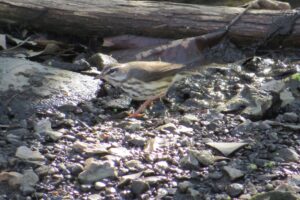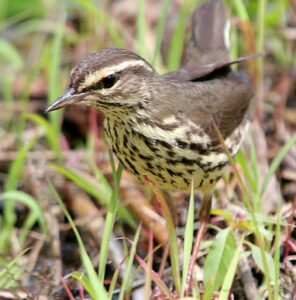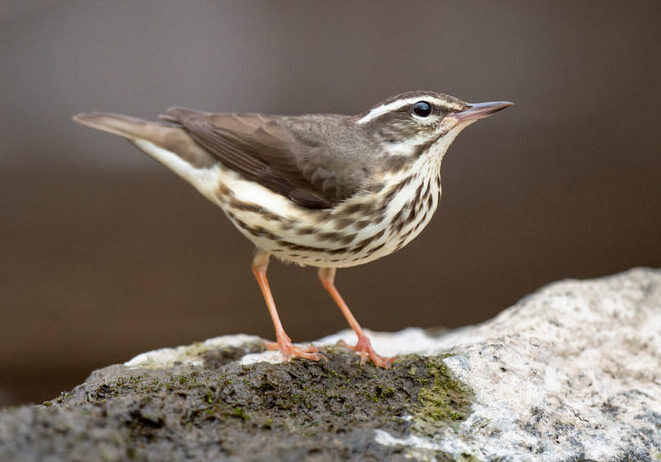Louisiana Waterthrush, Parkesia motacilla
Bill Rowe
Mostly unfamiliar to non-birders—and also not a thrush, but a warbler—the Louisiana Waterthrush is tied closely to flowing wooded streams; it nests throughout the eastern United States, except for the northernmost conifer forests and the flat coastal plains, including Florida. It is one of the earliest warblers to return from its Middle American wintering grounds, and even now, at the beginning of April, its loud, clear song may be part of the background music of any forest hike you take that passes by a creek. The breeding pairs, however, are well spaced along the length of the creek (an average might be one pair per kilometer) and therefore the actual number of waterthrushes you see and hear will not be large. Unlike other warblers that share the same general habitat but live up in the trees, such as the Northern Parula and Yellow-throated Warbler, the Louisiana Waterthrush lives on the creek itself, walking along the edges, constantly bobbing its rear end, and poking into the water and wet vegetation to locate small aquatic animal life, like the larvae of mayflies and caddisflies. Since these prey items are sensitive to the condition of the stream (e.g., its level of pollutants), the waterthrushes are too, and some studies have used their relative abundance or scarcity as a clue to stream condition. The Louisiana and its close cousin the Northern Waterthrush look somewhat like another common warbler, the Ovenbird, and used to be classified together with it in the same genus, Seiurus; but once again, genetic studies proved this to be incorrect, and the waterthrushes are now in a genus of their own, Parkesia, named for a recent ornithologist, Kenneth Parkes.
IDENTIFICATION: A thin-billed, sparrow-sized bird, brown above and streaked below with a bold eyebrow, puttering around the mud and gravel of a wetland, can only be a waterthrush—but which one? The Louisiana is our breeding species, and almost entirely limited to streamside habitat, although once in a while one may appear as a migrant outside of this context; the Northern Waterthrush, on the other hand, appears only during migration but much more widely, in variable habitats. Their songs are very different and often the best way to tell them apart. Separating them by appearance is much trickier: (1) Northerns often look pale yellowish all over but can be white; Louisianas are nearly always white on throat and breast but buffy on the rear flanks. (2) Breast streaking is denser in Northerns and includes the throat, sparser in Louisianas with little or none on the throat. (3) The eyebrow is longer and more expansive behind the eye in Louisiana but tapers off in Northern. This is a well-known problem, and not every waterthrush is easily identified even by experienced birders.
ST. LOUIS STATUS: Common within its narrow habitat choice, described above; seldom seen elsewhere. Leaves the breeding grounds early; may be mostly gone by mid-August. Waterthrushes seen later are nearly always Northerns.
Learn more and listen to the songs and calls of Louisiana Waterthrushes here.


Louisiana: Note broad, sparser streaking, with tiny spots on throat; white ground color with buff on flanks; slightly thicker bill.
Photo Credit: Bill Rowe
Northern: Note denser streaking, more distinct on throat; pale yellow tinge to face and underparts; slightly finer bill.
Photo Credit: Al Smith




